Sand fly vectors and transmission dynamics of visceral
leishmaniasis
The main vector of visceral
leishmaniasis (VL) in Sudan and Northern Ethiopia is Phlebotomus
orientalis, a sand fly frequently found in forests of Acacia
and Balanites trees where it transmits VL
to farmers and hunters during the dry season. However, P.
orientalis has also been documented inside villages and even
indoors transmitting leishmaniasis to the residents. Itis primarily a
lowland species, but in Ethiopia it is also found in altitudes of up to
2,000 m. It has a wide geographical distribution ranging across the
Sahel from Sudan and Ethiopia into Djibouti and south Kenya.
For monitoring Kala-Azar transmission in humans, the population density
of sand flies will be estimated during different seasons, levels of
human exposure to biting sand flies will be estimated by monitoring the
rates of sero-conversion to anti-sand fly saliva antibodies. The
reservoir potential of different populations such as VL as well as
post-kala azar dermal leishmaniasis (PKDL) patients will be determined.
Sand fly behavior and ecology will be studied by trapping in different
locations / using several methods including light traps, animal and
human landing collections and emergence traps for identifying larval
breeding habitats. The habitats and distances from which adult females
arrive at villages will be estimated using dyed sugar baits to mark
flies at different sites. Collections will be performed in and around
villages, at different times during the night and at different seasons
of the year. Host preferences of vector sand flies as well as Leishmania
infection rates will be determined using PCR.
Undoubtedly the widest gap in our knowledge of phlebotomine sand fly
biology remains their larval ecology. P. orientalis, the
main vector of VL were reported to emerge from cracks in vertisols.
Vertisols swell when wet and shrink when dry, consequently promoting
cracking in the dry season and flooding during the rainy season. To
characterize breeding habitats, sites where many flies emerge from
cracks will be compared with sites with relatively few sand flies. The
vegetation and/or farming activities will be documented , soil samples
will be obtained from different depths, chemically and physically
analyzed. Water content and temperature in the soil will be measured
continuously comparing productive sand fly breeding habitats and others
with very few sand flies. Results should should provide positive and/or
negative indicators for sand fly breeding sites.
A thorough understanding of the ecology and behavior of the vector(s)
constitutes a crucial aim of the proposed project: including: vector(s)
incrimination, where are sand flies breeding? What animals and plants
are they feeding upon? Where and when do they transmit L. donovani
to humans? A combination of strategies carefully selected following
comprehensive ecological/epidemiological studies, will be necessary to
combat VL in Ethiopian foci.
Project personnel
- Alon
Warburg, PhD (Principal Investigator) team leader: alonw@ekmd.huji.ac.il
- Ibrahim Abassi, PhD (Research associate): ibrahim@md.huji.ac.il
- Roy Faiman, MSc (PhD student): roy.faiman@mail.huji.ac.il
- Adi Moncaz, MSc
(PhD student): moncaz@walla.com
- Oscar David Kirstein, MSc (PhD candidate): od.kirstein@mail.huji.ac.il
- Samar Aramin (MSc student): samar.aramin@gmail.com
Alon Warburg’s Vector Biology
Laboratory is at the Kuvin Center
for the Study of Infectious and Tropical Diseases within The
Institute for Medical Research Israel-Canada at the Hebrew
University Faculty of Medicine
in Ein Kerem, Jerusalem, Israel. Alon has been studying sand fly
vectors of leishmaniasis for many years in several countries. He has
also conducted laboratory studies on the development of Leishmania
in sand flies as well as Plasmodium (malaria) parasites in
mosquitoes.
Selected Publications
- Wasserberg G., Abramsky Z., Kotler
B.P., Ostfeld R. S., Yarom I .,Warburg A. 2003. Anthropogenic
disturbances enhance occurrence of cutaneous leishmaniasis in Israel
deserts: patterns and mechanisms. Ecol Applications
13: 868-881.
- Jacobson R.L., Eisenberger C.
L., Svobodova M., Baneth G., Sztern J. Carvalho J.,
Naseredeen A., El Fari M. Shalom, U. Volf P. Votypka
J. , Dedet J. Pratlong F. , Sch?nian G. , Schnur L. F.
, Jaffe C. L. and Warburg A. 2003. Outbreak of cutaneous
leishmaniasis in Northern Israel. J Inf Dis 7:
1065-1073.
- Wasserberg G , Yarom, and Warburg A.
2003. Seasonal Abundance Patterns of Phlebotomus papatasi
(Diptera: Psychodidae) in Two Climatically Distinct Foci of Cutaneous
Leishmaniasis in Israeli Deserts. Med Vet Entomol, 17:
452-456.
- Schnur L.F., Nasereddin A.,
Eisenberger C., Jaffe C.L., El Fari, Azmi K., Anders G.,
Killick-Kendrick R., Dedet J-P., Pratlong G., Kanaan M., Grossman
T., Jacobson R.L., Schonian G., and Warburg A. 2004. Multifarious
characterization of Leishmania tropica from a Judean desert
focus, exposing intraspecific diversity and incriminating Phlebotomus
sergenti as its vector. Am J Trop Med Hyg 70:
364-372.
- Jaffe C.L. , Baneth G. , Abdeen Z. ,
Schlein, Y . and Warburg ,A 2004. Leishmaniasis in Israel and the
Palestinian Authority. Trends Parasitol, 20: 328-332
- Kravchenko, V., Wasserberg, G. &
Warburg, A. 2004. Bionomics of phlebotomine sandflies in the Galilee
focus of cutaneous leishmaniasis in northern Israel. Med Vet
Entomol. 18:418-428.
- Svobodov?, M . Vot?pka, J . Peckov?,
J . Dvo??k, V . Nasereddin, A. , Baneth, G. , Sztern, J. Kravchenko,
V . Orr. A. Meir, D . Schnur, L.F . Volf, P. and Warburg, A.
(2006). Distinct transmission cycles of Leishmania tropica in
2 adjacent foci, northern israel. Emerg Infect Dis, 12:
1860-1868.
- Warburg, A. Shtern, S. Cohen
,N. and Dahan, N. (2007). Laminin and a Plasmodium
ookinete surface protein inhibit melanotic encapsulation of Sephadex
beads in the hemocoel of mosquitoes. Microbes Infect, 9:
192-199.
- Warburg, A, Gelman S . &
Deutsch J . (2008). Xanthine in urine stimulates growth of Leishmania
promastigotes in vitro. J Med Microbiol, 57:
136-138.
- Warburg, A. (2008). The structure of
the female sand fly (Phlebotomus papatasi) alimentary canal. Trans
R Soc Trop Med Hyg, 102: 161-166.
- Sirak-Weizman, M., Cunio R., Faiman
R. & Warburg A. (2008). Control of phlebotomine sand flies in
confined spaces using diffusible repellents and insecticides. Med
Vet Entomol, 22:405-412
- Abbasi, I. Cunio, R. & Warburg,
A (2009). Identification of blood meals imbibed by phlebotomine sand
flies using cytochrome b PCR and reverse line blotting. Vec
Borne Zoonot Dis 9: 79-86.
- Faiman, R , Cu?o, R
and Warburg A (2009).
Comparative efficacy of three suction traps for collecting phlebotomine
sand flies (Diptera:Psychodidae) in open habitats. J Vec Ecol 34:114-118.
- Faiman, R , Cu?o, R
and Warburg A (2009). Control
of Phlebotomine Sand Flies with Vertical Fine-Mesh Nets. J Med
Entomol ,46: 820-831.
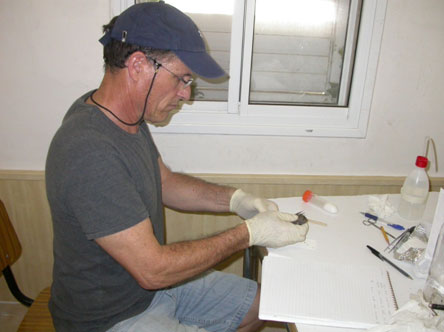
Alon, dissecting voles to determine infection rates with Leishmania
major in Sde Eliyahu
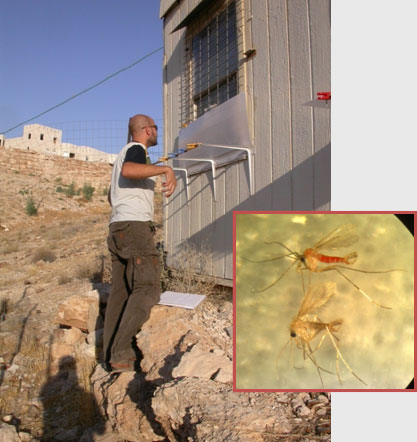
Oscar, counting marked sand flies trapped on sticky surface under the
window of an experimental house in Kfar Adumim
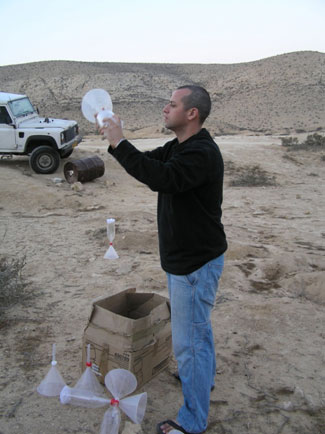
Roy, examining emergence traps for presence of sand flies (Sde Boker)
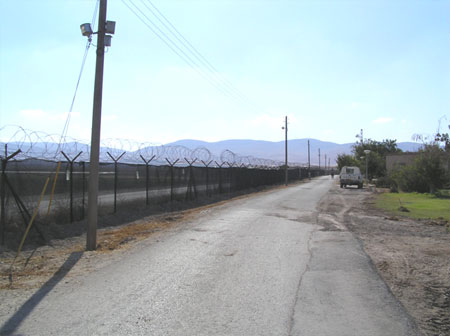
The flight barrier against sand flies transmitting cutaneous
leishmaniasis in Sde Eliyahu
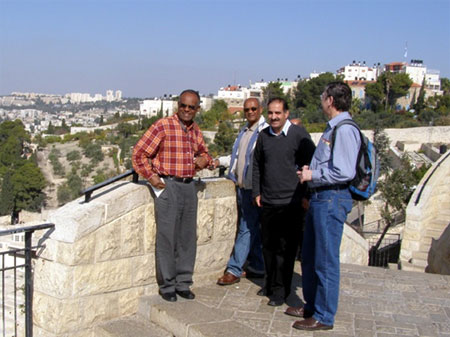
Ibrahim Abassi (center right) with Asrat Hailu (left), Teshome
Gebre-Michael (center left) and Petr Volf (right) during a tour of
Jerusalem (Nov 2009)
|














